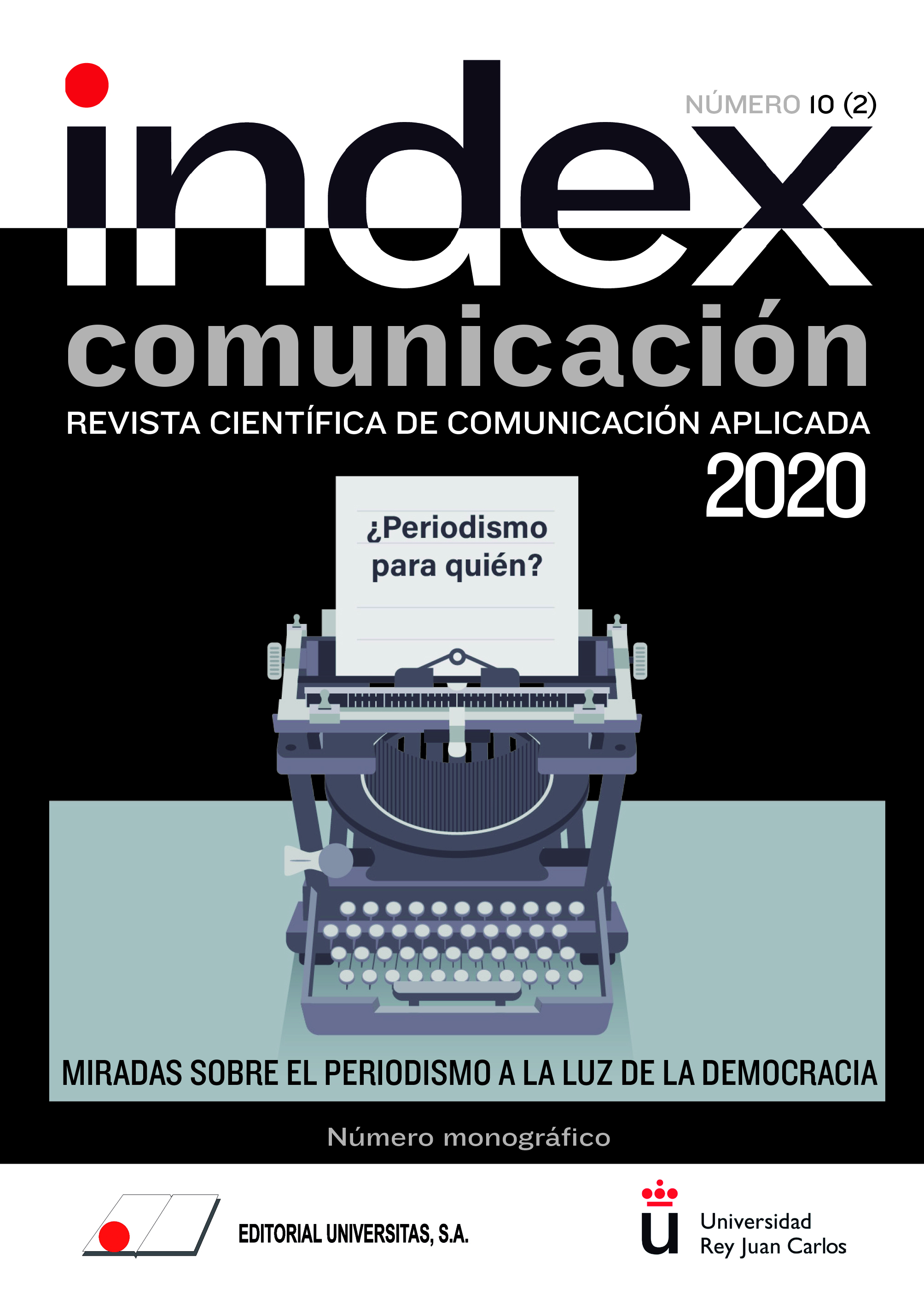Polarization and media shielding: the questioning of journalistic mediation
DOI:
https://doi.org/10.33732/ixc/10/02PolariKeywords:
media shielding, journalism, alternative media, main nedia, political polarizationAbstract
The article analyses denunciations of media shielding operated by the alternative media with a view to the performance of the reference media. Paying attention to the context of digital convergence associated with political polarization, we study the crisis faced by journalistic mediation that allowed him to question his competence and communicational legitimacy. The analysis results from the composition of corpora formed by articles published between the years 2010 and 2015, election period and the governments of President Dilma Rousseff, by Brazilian electronic portals, websites and blogs. Among the results, there are procedures that recognize the use of shielding as an action of the reference media that acquires reverberation in the alternative media sphere when it lists complaints about the strategies used in situations recognized as shielding. His responsibility as an agent of socio-political polarization is unavoidable, given that he collaborated on laying the foundations for the practice of disseminating false news that had a wide impact on Brazil's 2018 presidential election.
Metrics
References
ALDÉ, A.; ESCOBAR, J.; CHAGAS, V. (2007). A febre dos blogs de política. Revista Famecos, Porto Alegre, 14(33), 29-40.
ABRAMO, P. (1988). Imprensa Alternativa: alcance e limites. Revista Tempo e Presença, 233, agosto.
AMARAL, A; RECUERO, R & MONTARDO, S. (Orgs.). (2009). Blogs.Com: estudos sobre blogs e comunicação. São Paulo: Momento Editorial.
BAUER, M. W. & AARTS, B. (2002). A construção do corpus: um princípio pra a coleta de dados qualitativos, 39-63. In M.W. BAUER & G. GASKELL. Pesquisa qualitativa com texto, imagem e som. Petrópolis: Vozes.
BRUNS, A. (2005). Gatewatching: Collaborative online news production. Nova Iorque: Peter Lang.
CHARAUDEAU, P. (2013). Discurso das mídias. São Paulo: Contexto.
CHARAUDEAU, P. (2014). Estratégias de discurso, 93, 143-144, 218–219, 295. In P. CHARAUDEAU & D. MAINGUENEAU. Dicionário de análise do discurso. São Paulo: Contexto.
DEUZE, M. & WITSCHGE, T. (2015). Além do jornalismo. Leituras do jornalismo, 2(2), 1-31.
ERBOLATO, M. (2001). Técnicas de codificação em jornalismo: redação, captação e edição no jornal diário. São Paulo: Ática.
FRANÇA, V. & QUÉRÉ, L. (2003). Dos modelos da comunicação. Fronteiras – Estudos Midiáticos, V(2), 37-51.
GERALDES, E. C. et al (Org.). (2016). Mídia, misoginia e golpe. Brasília: FAC-UnB.
GIDDENS, A. (2002). Modernidade e identidade. Rio de Janeiro: Jorge Zahar.
HARTMANN, C. & SILVEIRA, A.C.M. (2017). Desigualdade, violência e drogas na pauta noticiosa. Tipificação do heteronormativo na narrativa jornalística. 352-368. In L. AGUIAR; M. P. SILVA & M. MARTINEZ. Desigualdades, relações de gênero e Estudos de Jornalismo. São Paulo: LIFE/Intercom.
HARTMANN, C. & SILVEIRA, A.C.M. (2018). Convertendo a exclusão social em notícia: a visibilidade da periferia em capas de revista, 201-220. In M. R. SILVA et. al. (Orgs.). Mobilidade, Espacialidades e Alteridades. Salvador/Brasília: EdUFBA/Compós.
KUCINSKI, B. (2018). Jornalistas e revolucionários: nos tempos da imprensa alternativa. São Paulo: Edusp.
LIMA JUNIOR, W. T. (2009). Mídia social conectada: produção colaborativa de informação de relevância social em ambiente tecnológico digital. Líbero, 12(24), 95-106.
MACHADO, A. (2002). Apresentação à edição brasileira, 9-15. In J. DOWNING. Mídia Radical: rebeldia nas comunicações e movimentos sociais. São Paulo: Senac.
MANNA, N.; JÁCOME, P. & FERREIRA, T. (2017). RECONTEXTUALIZAÇÕES DO _ISMO: Disputas em torno do jornalismo «em crise». Revista Famecos, 24(3). doi.org/10.15448/1980-3729.2017.3.26991
MIDIA DADOS. (2014). São Paulo: Grupo Mídia de Mídia. Acesso em 28 out. 2018 em: https://www.gm.org./midiadados.
MIGUEL, L. F. (2019). Jornalismo, polarização política e a querela das fake news. Estudos de jornalismo e mídia, Florianópolis, 16(2), 42-58.
ORLANDI, E. P. (2009). Análise de Discurso: princípios & procedimentos. Campinas: Pontes.
PASQUALE, F. (2017). A esfera pública automatizada. Líbero, 20(39), 16-35.
PERUZZO, M. K. (2009). Aproximações entre comunicação popular e comunitária e a imprensa alternativa no Brasil na era do ciberespaço. Galáxia, 17, 131-146.
ROCHA, H. C. L. & MARROQUIM, R. S. M. (2011). O papel do jornalismo no processo democrático: a ética do discurso como essência da democracia deliberativa. Estudos em Comunicação, Covilhã, 9, 143-160.
SILVEIRA, A.C.M. (2016). Panorama dos sistemas irradiadores na Amazônia brasileira: rádio e TV, 60-103. In J.T. VARGAS & D.S. FARIA (Orgs.). Textos interdisciplinares. São Paulo: Humanitas/UFOPA.
SODRÉ, M. (2010). Jornalismo como campo de pesquisa. Brazilian Journalism Research, 6(2), 7-16.
SOUZA, J. (2016). A radiografia do golpe. Rio de Janeiro: Leya.
TODOROV, T. (1995). Em face do extremo. Campinas: Papirus.
WERNECK SODRÉ, N. (1999). História da imprensa no Brasil. 4a ed. [atualizada], Rio de Janeiro: Mauad.
WOLF, M. (2001). Teorias da comunicação. Lisboa: Presença.
Published
How to Cite
Issue
Section
License
Copyright (c) 2020 Ada Cristina Machado da Silveira, Camila Hartmann, Clarissa Schwartz

This work is licensed under a Creative Commons Attribution-NonCommercial 4.0 International License.
Authors who submit to this journal agree to the following terms:
Authors retain copyright and ensure the magazine's right to be the first publication of the work as licensed under a Creative Commons Attribution-NoComercial 4.0 International License that allows others to share the work with an acknowledgment of authorship of the work and the initial publication in this magazine, with no commercial purpose.
Authors can establish separate additional agreements for non-exclusive distribution of the version of the work published in the magazine (for example, to an institutional repository or publish it in a book), with an acknowledgment of its initial publication in this journal.
It allows and authors are encouraged to disseminate their work electronically (eg, in institutional repositories or on their own website) prior to and during the submission process, as it can lead to productive exchanges, as well as a citation more early and most of the published work (See The Effect of Open Access).















